Ole Gunnar Solskjær traveled with his men to the French capital for the inaugural game week of the 20/21 UEFA Champions League season 19 months after the historic night at Parc des Princes when Manchester United overturned a 2-0 deficit of the first leg with an incredible 3-1 victory against Paris Saint-Germain to become the only team ever to do so.
Paris Saint-Germain came into this game on the back of five successive wins, scoring 16 and conceding just one in those games, after starting the season sluggishly with 1-0 defeats over the opening two Ligue 1 fixtures.
Similarly, United also started the season poorly with two defeats in the first three Premier League games, which also includes the 6-1 battering by Tottenham at Old Trafford. The most recent 4-1 win in the Premier League over Newcastle United seemed to have gathered some momentum for the Red Devils as they looked to come into their grove.
Indeed, Manchester United put up a strong performance to beat the French champions 2-1 and created yet another history by becoming the only team to beat PSG twice at their home turf in the Champions League. In this tactical analysis, we will do an analysis of the tactics employed by both the managers. We will also see how Solskjær’s United outclassed Thomas Tuchel’s men in an important game.
Lineups
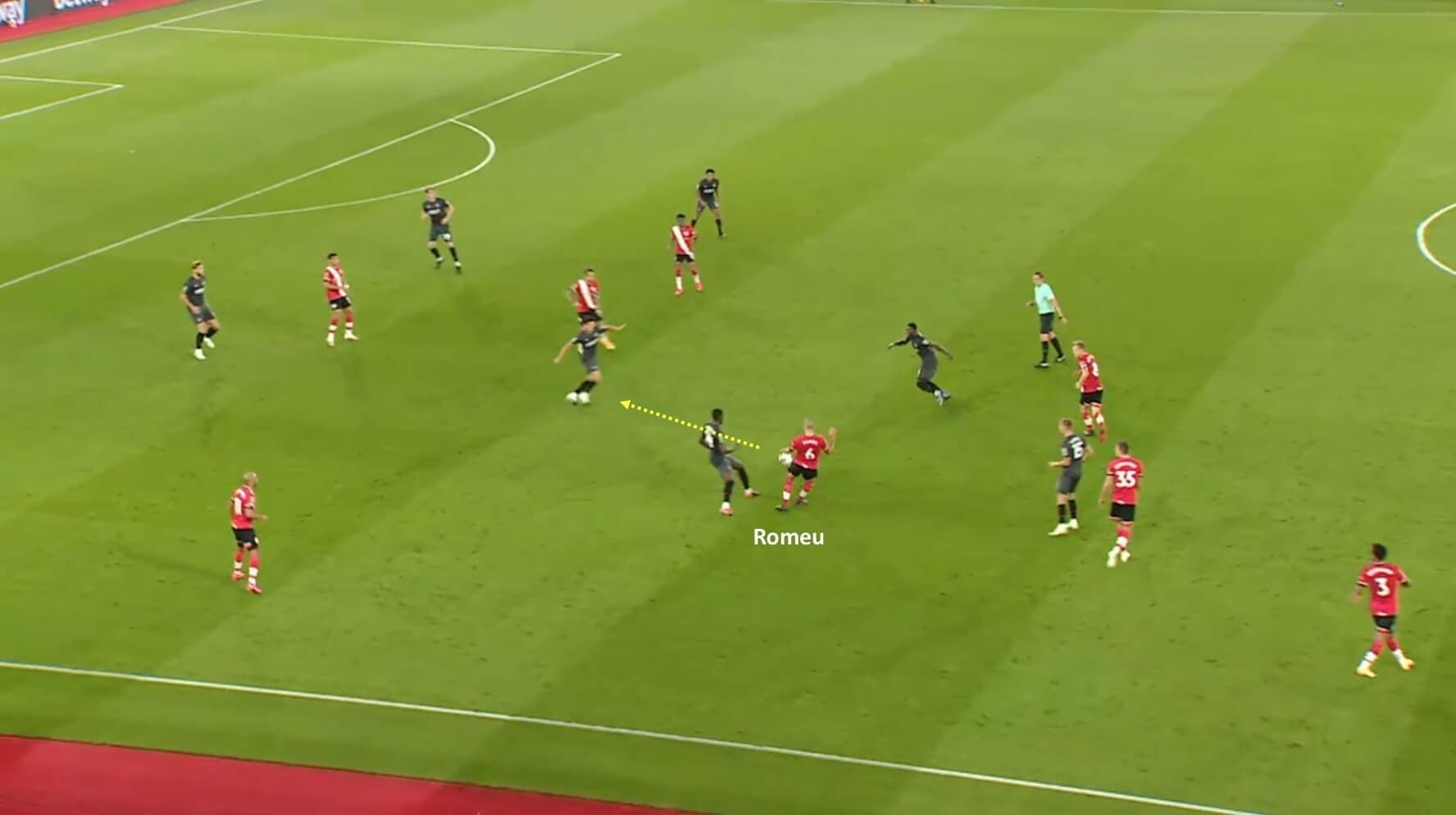
Injuries to several key players forced Tuchel to make personnel changes in his favoured 4-3-3 system. Layvin Kurzawa returned to the starting lineup after suspension as he replaced injured Mitchel Bakker at the left-back. Danilo Pereira and Ander Herrera replaced Leandro Paredes and Rafinha in the midfield alongside Idrissa Gueye. Other notable returns were Ángel Di María and Neymar on both sides of the wings and formed a formidable trio along with Kylian Mbappé, who played centrally in Mauro Icardi’s absence.
As for United, Harry Maguire’s absence naturally weakened the United backline. Hence, Solskjær provided extra protection at the back by opting for the 5-3-2 system without possession. The captain was replaced by Axel Tuanzebe, who returned to the starting lineup after over a year. Luke Shaw was deployed as a makeshift centre-back on the left as he had displayed stellar performances in that position during the previous season. This paved the way for the debut of Alex Telles, who occupied the vacant wing-back position on the left. Anthony Martial returned to the team after missing out the league game against Newcastle due to suspension while the new signing Facundo Pellistri was named on the bench.
United’s dominance in high pressing tactic during the first half
Both the managers like to dominate games by keeping more possession as PSG’s 61.9% and United’s 54.1% average possession in their respective leagues so far during the current season suggest. When a team likes to keep more possession, it is key that they press the opposition high in order to win the ball quickly. While both the teams were set up to press from the front, Solskjær’s men did it better as we shall see it causes in this section.
United had employed a man-oriented high pressing structure off the ball, as shown in the figure below.
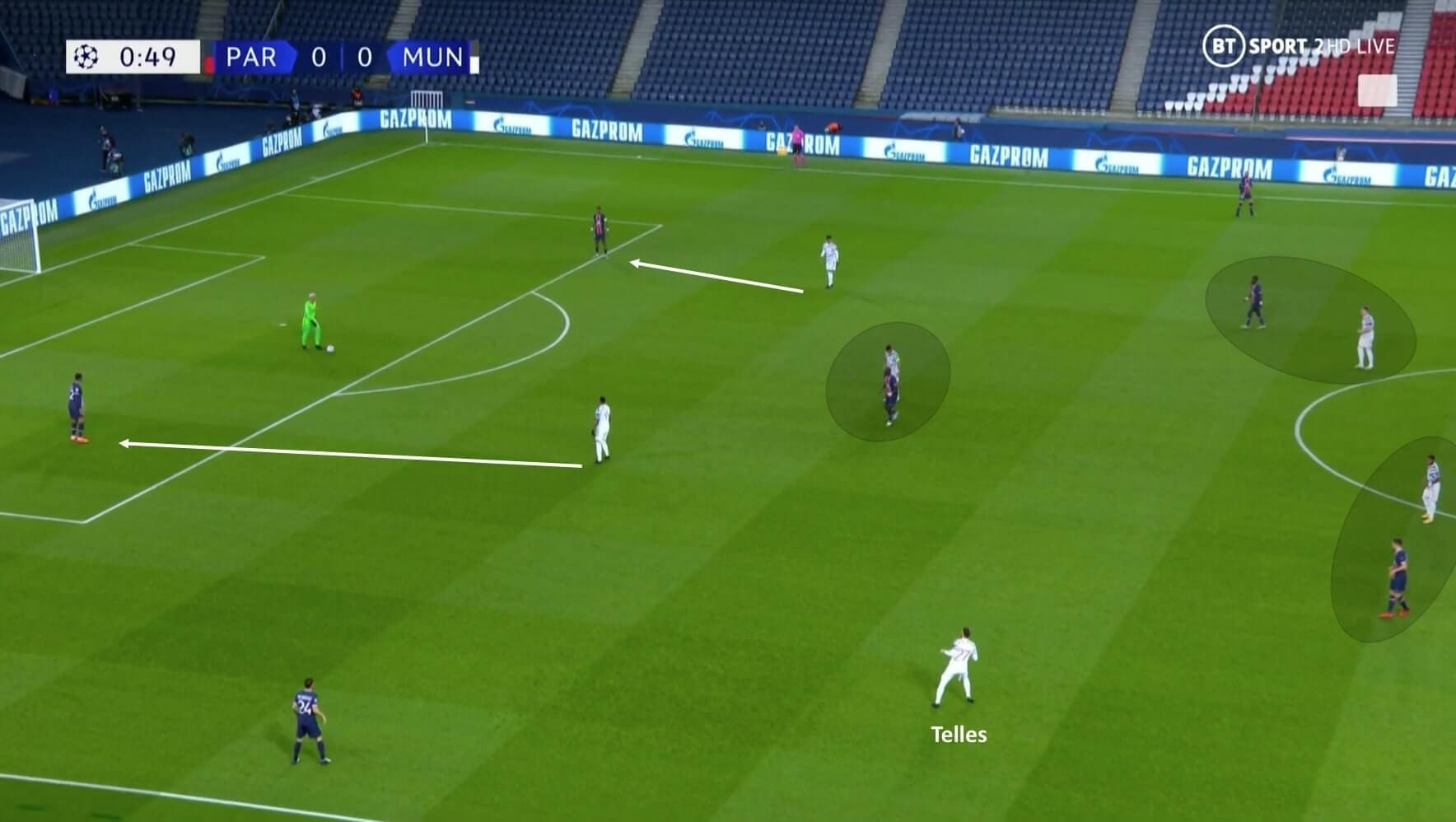
As you can see, United’s attacking trio formed a narrow front pressing shape to occupy PSG’s two centre-backs and the lone pivot Pereira. Behind them, Scott McTominay and Fred stayed closer to the two central midfielders. Notice that United’s full-backs did not mark the opposition full-backs tightly as they positioned themselves near the half-way line inviting the goalkeeper to pass the ball wide.
Once the ball went to a wide defender, United’s ball near full-back would push high and press the PSG full-back in possession. This would congest the space and block all the short passing lanes to compel the man with the ball to go long consequently causing a turnover. The following figure shows an instance of that.
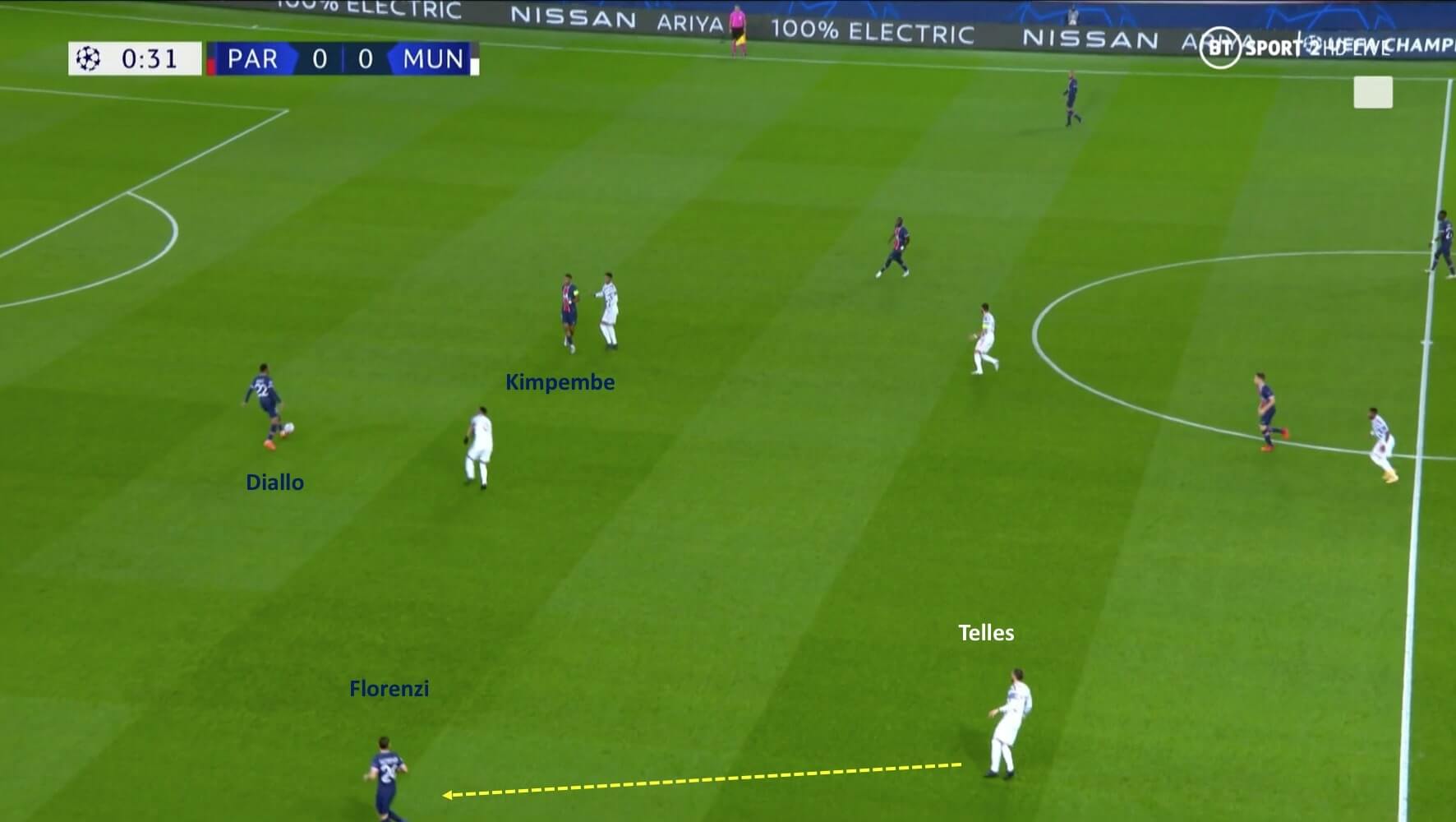
Moments before capturing the above snapshot, Presnel Kimpembe was travelling towards the right with the ball with an intention to look for a pass to Alessandro Florenzi on the flank. Telles quickly pushed high near the full-back to close him down. However, Kimpembe settled with a pass to Abdou Diallo.
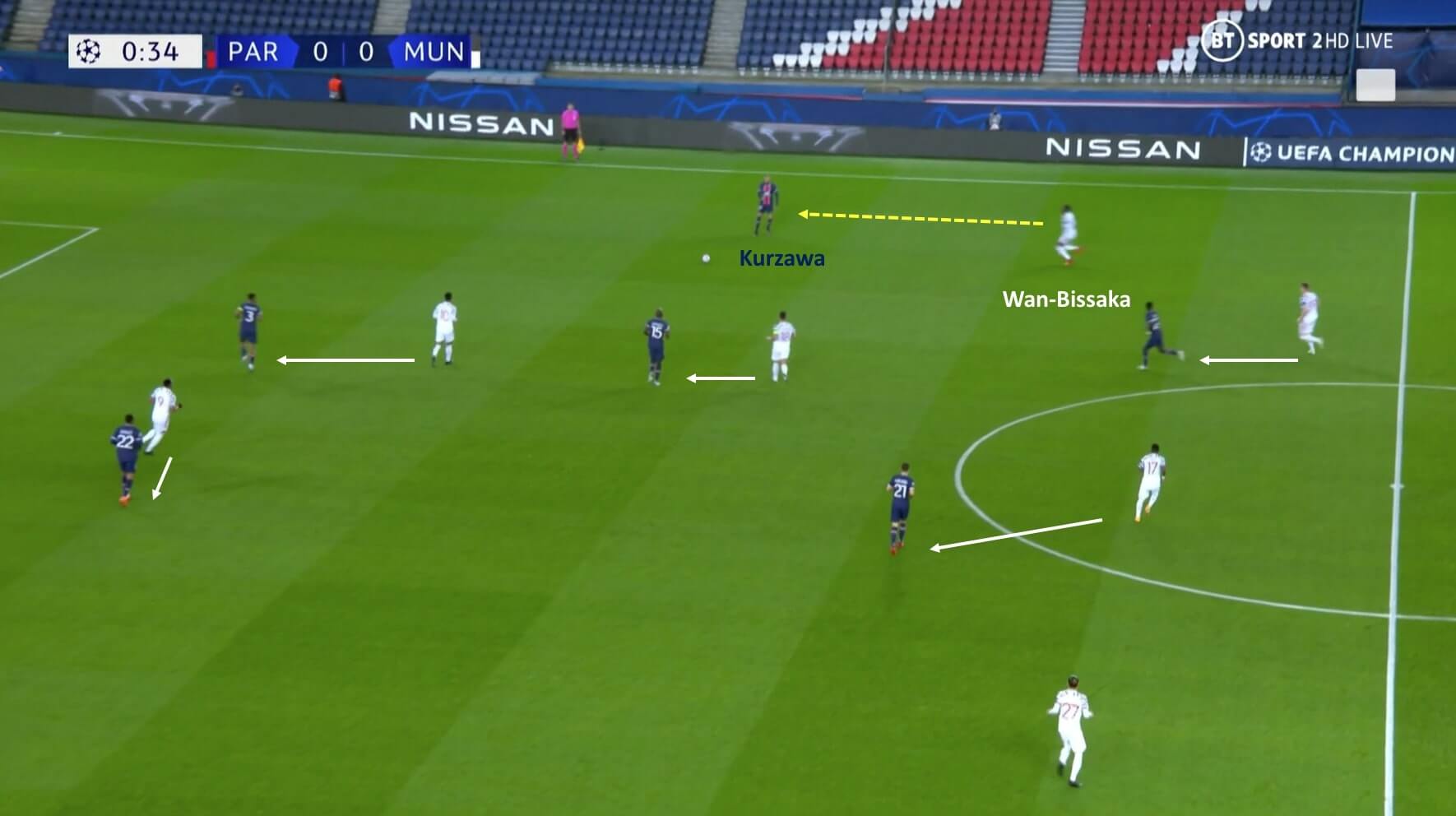
Three seconds later, as the ball travelled from right to left towards Kurzawa, Aaron Wan-Bissaka left his line and started to press the man in possession. Observe that all the short passing routes have been shut down by the United man-marking approach.
The previous three images clearly indicate Solskjær’s high pressing tactic for this game. It worked effectively as more than 48% of PSG’s ball losses were caused in their own half. Not only that, the high press of the visitors prevented ball progression consequently nullifying the threat of PSG’s front-three to a large extent as they were limited to only four shots in the first half.
The high pressing structure of Les Parisiens was similar to that of United’s. The front-three was supposed to press United’s back-three while the three central midfielders were assigned to mark the two pivots and Bruno Fernandes. Having said that, PSG’s high press was largely ineffective due to an intelligent buildup structure of the away side and a lack of pressing intensity from PSG’s attacking trio.
During the first phase, United transitioned their back-three system into a back-four as Luke Shaw occupied the left full-back position allowing Telles to push high into the midfield. The structure is represented in the image below (Red – United, Blue – PSG).
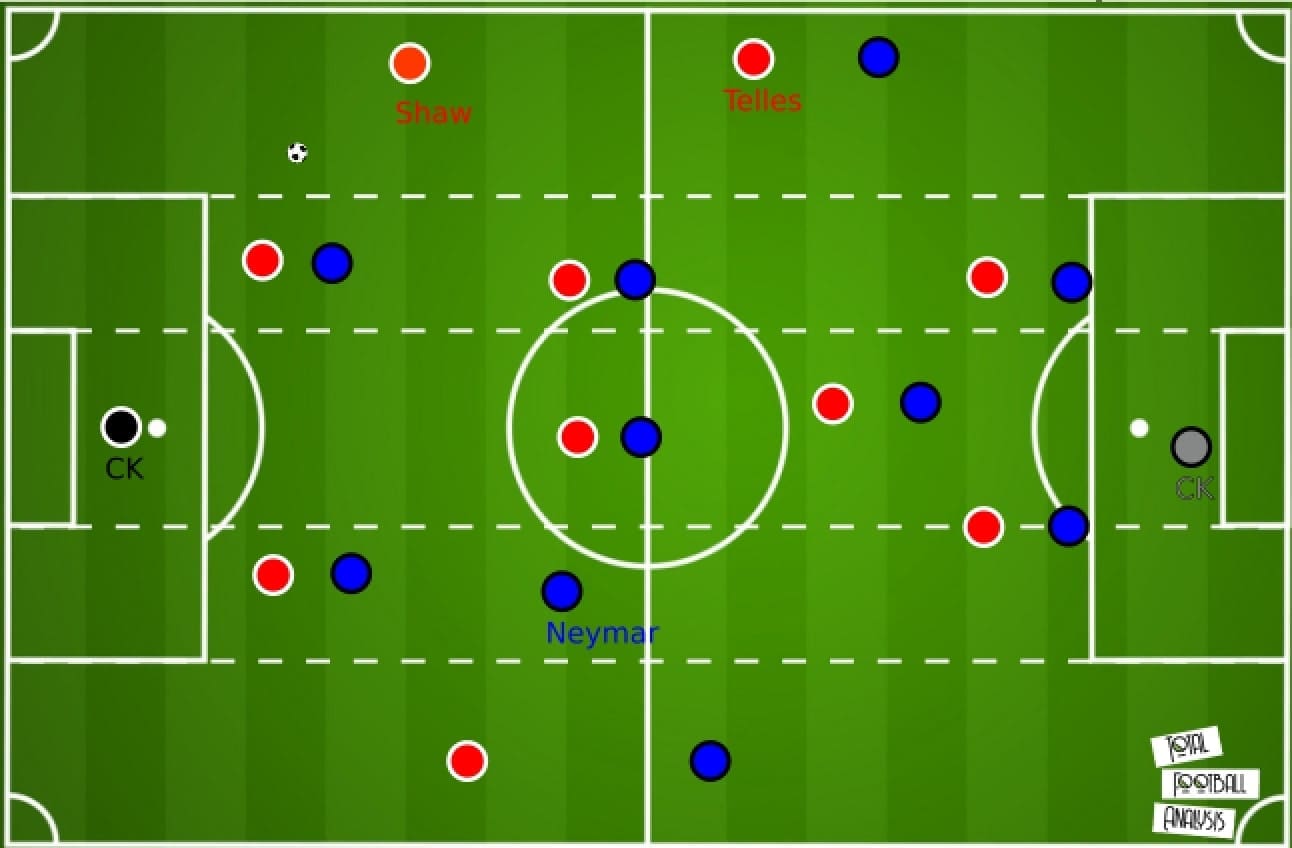
Neymar mostly stayed in the midfield line and did not participate in the high press which forced the remaining forward players to mark the United centre-backs. Since Telles pinned Florenzi deep, Luke Shaw was an extra man at the back who stayed unmarked, thus providing a numerical advantage to the visitors in their buildup.
The following figure shows an in-game example of it. While Neymar did not participate in the high press, the intensity of Mbappé and Di María to press Tuanzebe and Victor Lindelöf was not impressive. Hence, the Red Devils had more numbers at the back which left Shaw free on the left flank to open up an easy passing route for Lindelöf.
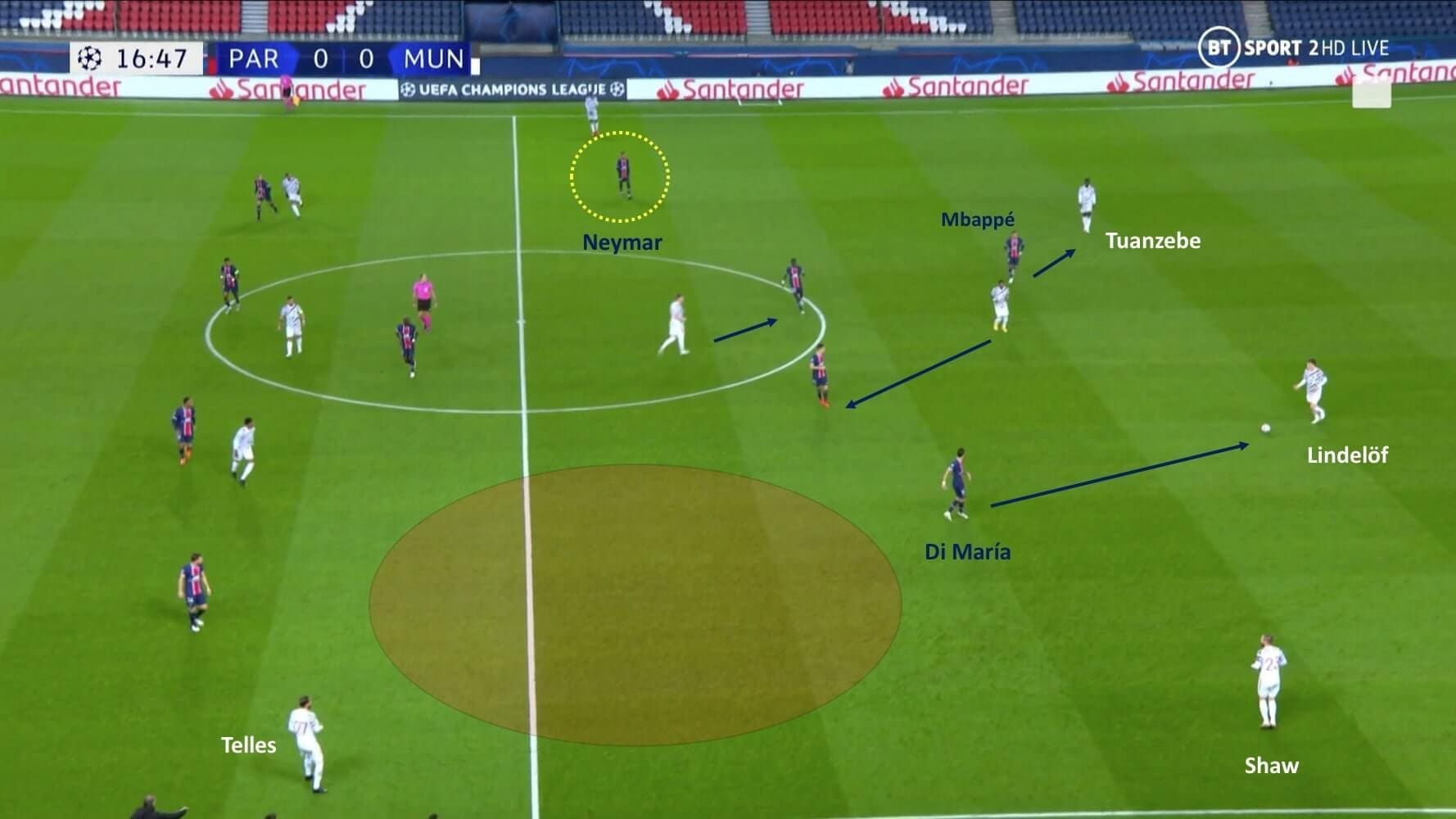
An interesting aspect to notice here is the space that Shaw was provided in front of him. As the 25-year old received possession, he looked to quickly progress the ball vertically by either driving with it or through a progressive pass for one of the United attackers who would drop deep into the space between the lines. Indeed, the Englishman made 13 forward passes, which was highest amongst his teammates, with 100% accuracy. Moreover, he also made five passes into the final third, one key pass, and one deep completion. These metrics suggest that the attacking output provided by Shaw was imposing. The following short passing map of David De Gea also indicates the use of Shaw during the buildup.
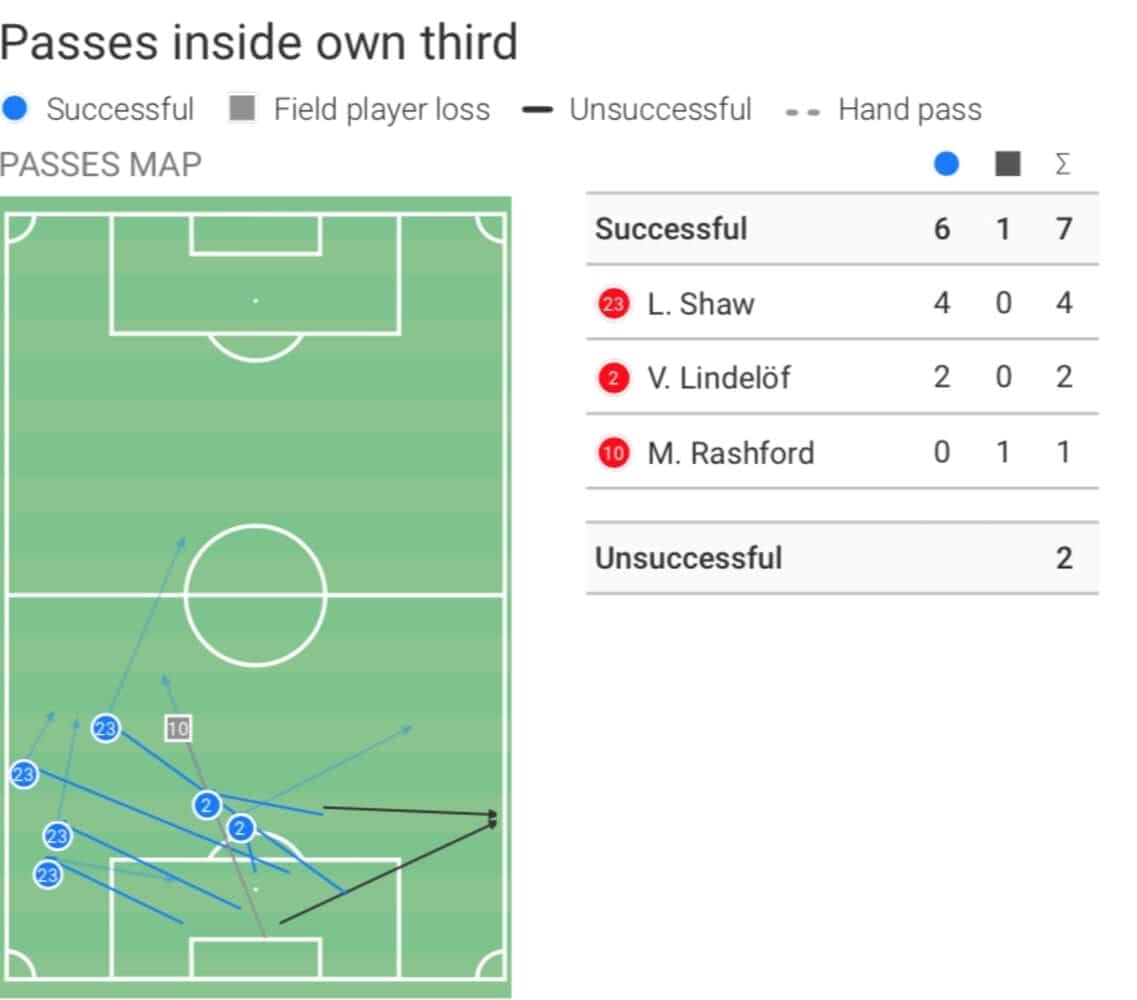
The initial buildup structure of 2-4-4, as shown in the previous image, transitioned into a 2-3-5 as Shaw’s ball progression would allow Wan-Bissaka to push into the forward line on the right. The following average position map of United highlights Shaw’s (#23) position higher up the pitch on the left-hand side that also allowed Telles to move further up the pitch.
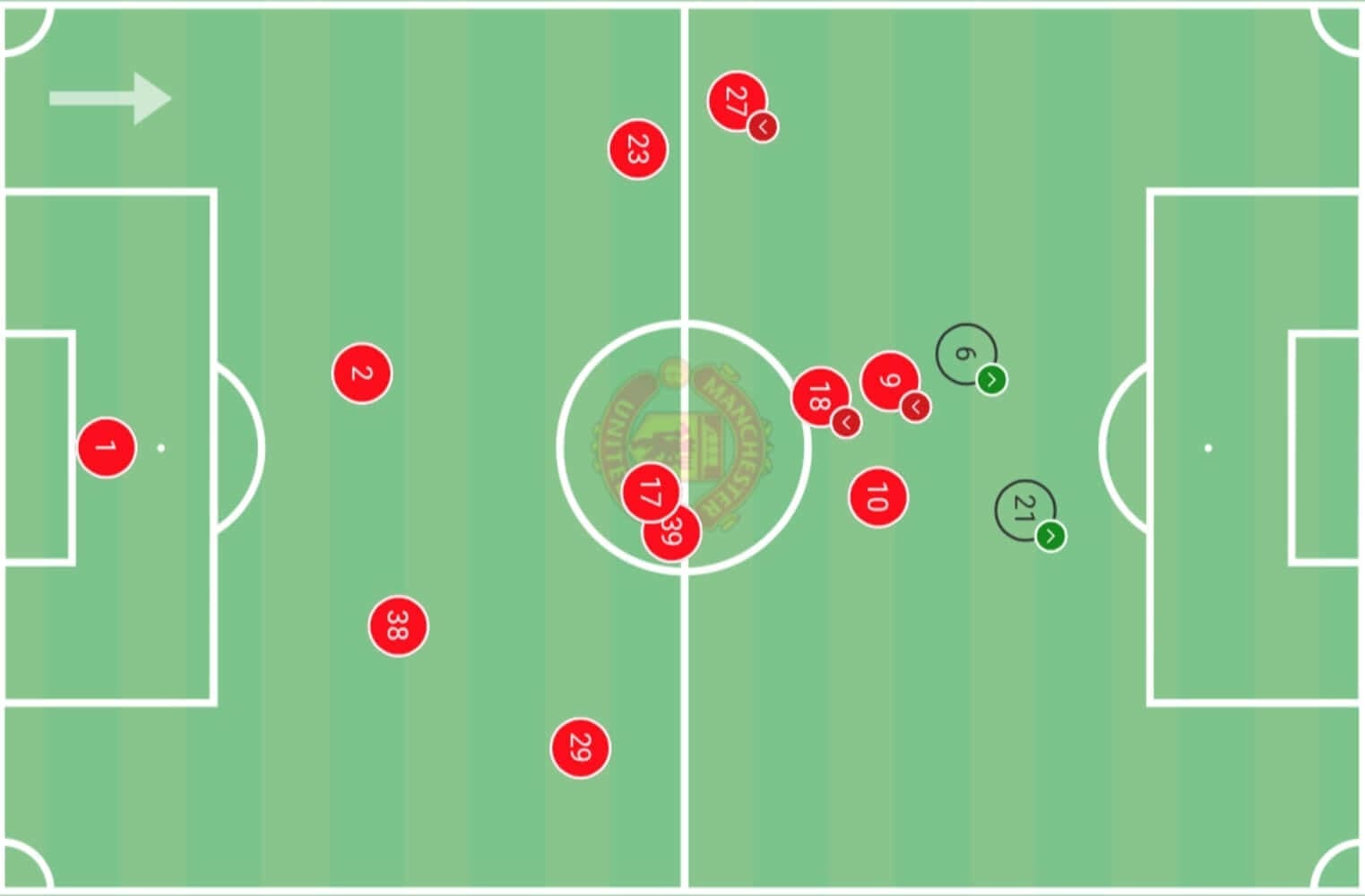
As the first half progressed, Tuchel realized the issue with their pressing structure as he instructed Di María or Herrera to close down Shaw quickly. This tactical tweak did not help PSG. Albeit it reduced Shaw’s effectiveness with the ball, United started to create new problems for PSG defenders. Telles and Fernandes started to make intelligent movements off the ball to create space for Rashford across the left channel in the final third. The following set of images exemplifies it.
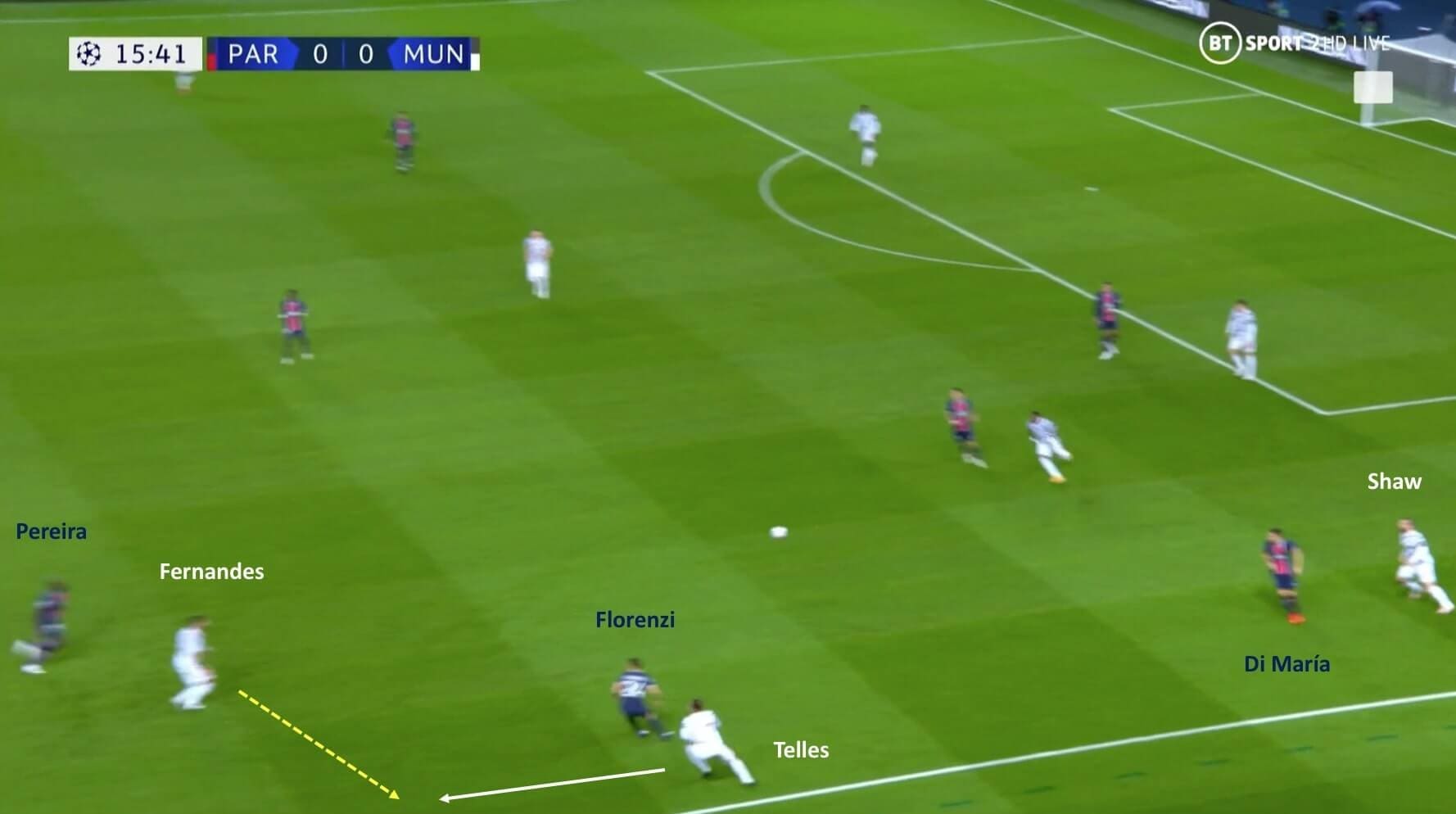
In the figure above, as Di María pressed Shaw into the defensive third early, Telles and Fernandes dropped deep into their own half consequently drawing Florenzi and Pereira out of their defensive positions. Fernandes laid the ball off for Telles using his chest as the Brazilian full-back started to make a run facing the goal, as shown in the figure below.
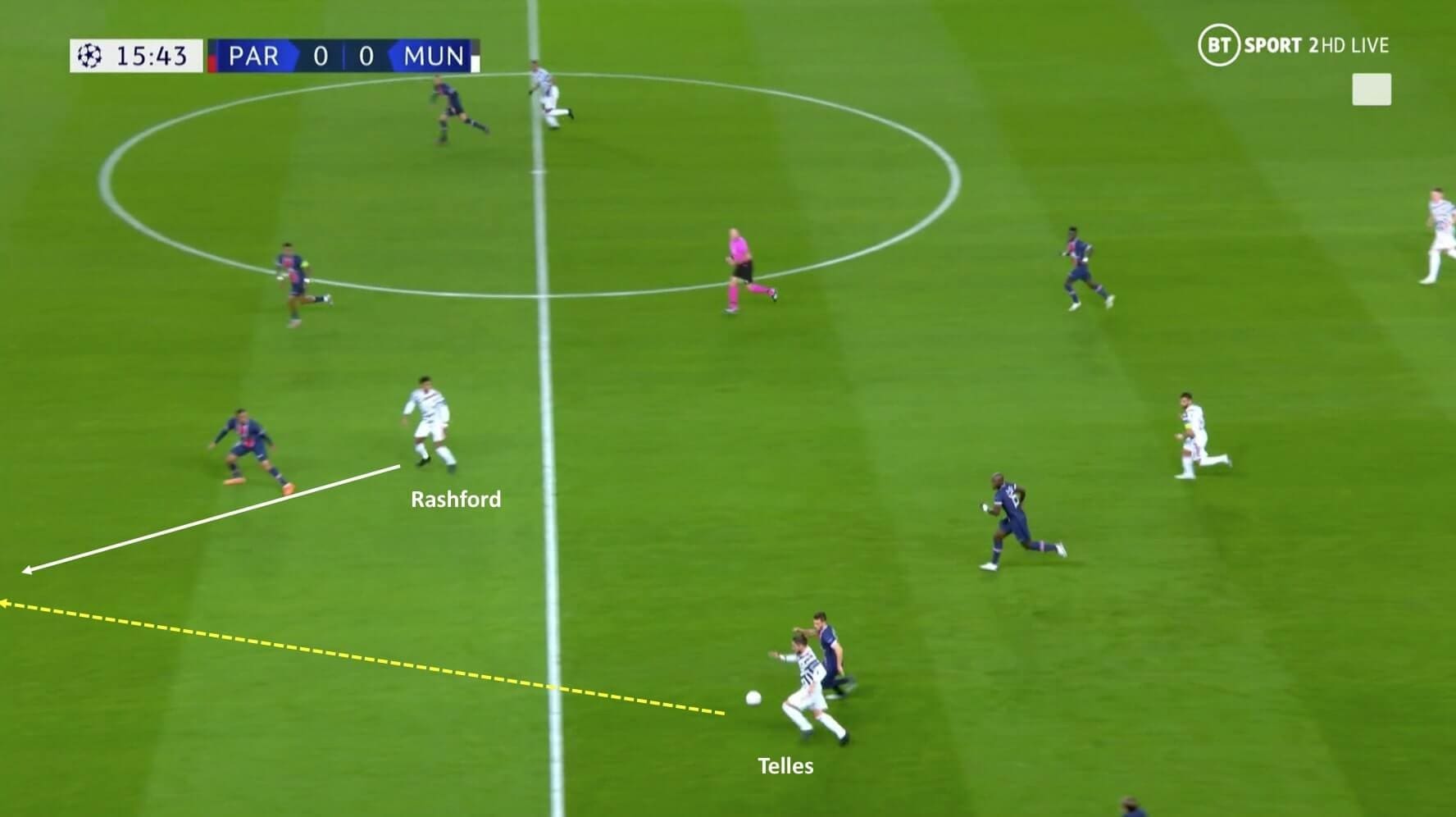
The movement from Telles and Fernandes created space in the outside channel for Rashford, who could now use his pace to expose the high backline of the hosts.
A few minutes later, Telles and Fernandes once again created space in the final third for Rashford, but this time in the inside channel. The following images showcase the scenario.
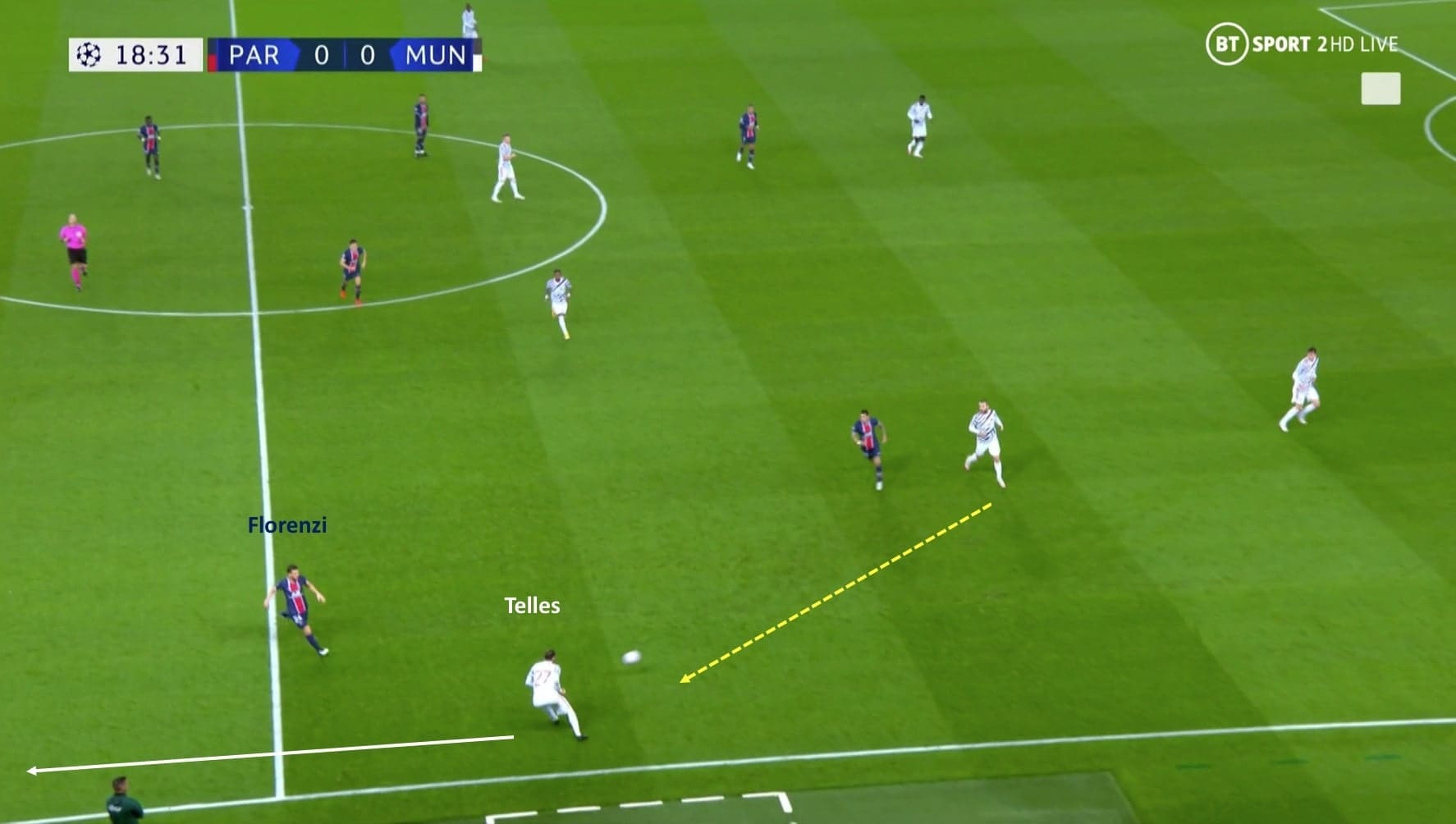
Since Florenzi was late on Telles, the debutant got an opportunity to create a half-turn and make a vertical pass in the channel for Fernandes, who had made a run into a wide position this time, as shown in the following image.
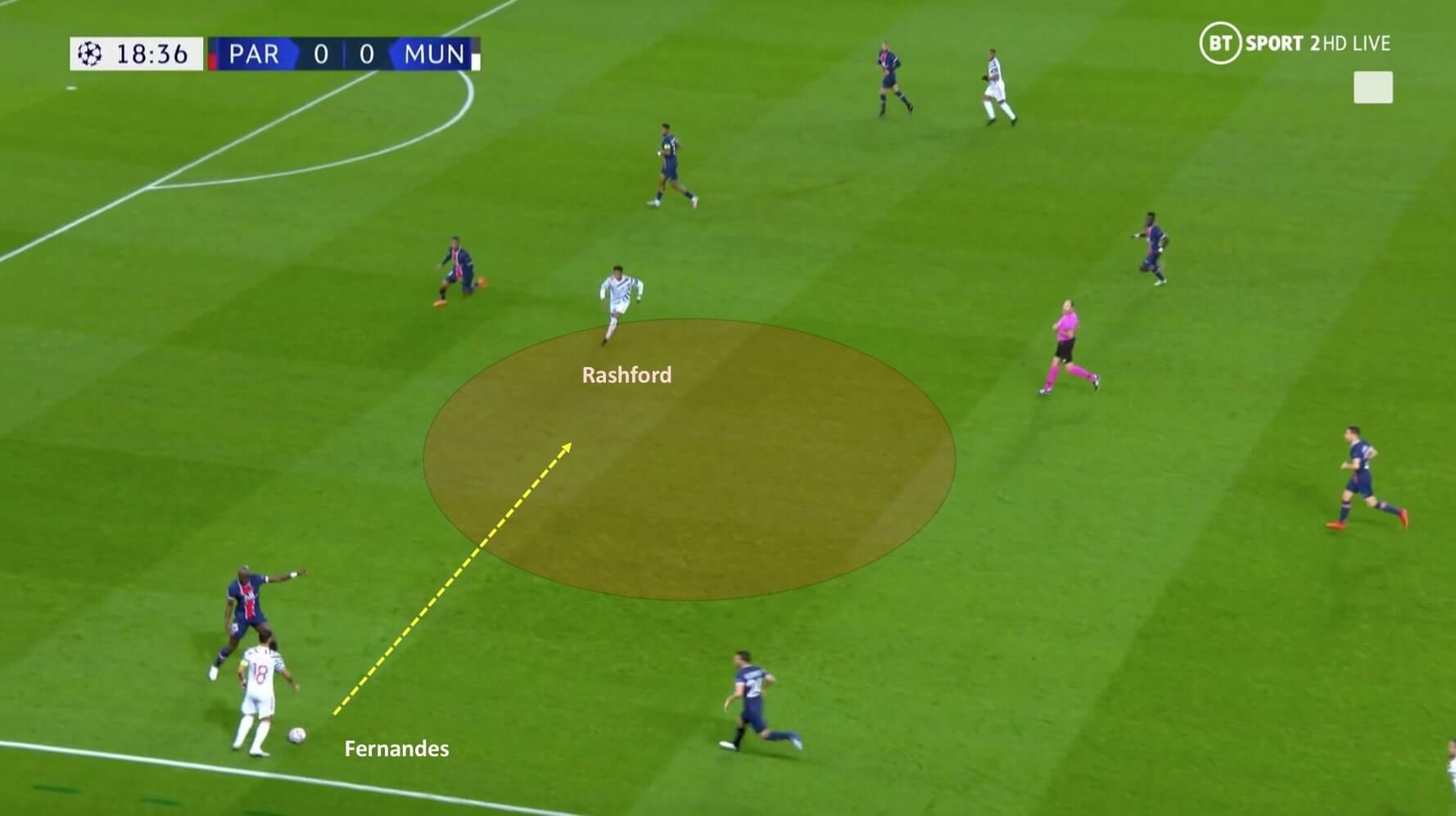
Once again, Florenzi and Pereira got dragged out of their positions to create space in the half-space for Rashford.
PSG’s defensive issues were largely related to their attacking trio. Not only were they ineffective with their front pressing (as mentioned earlier), but they were also unwilling to drop back into a defensive shape when United entered their half. Hence, it provided ample space to the visitors in the inside and wide channels and allowed Solskjær’s men to maintain a numerical and positional advantage in the final third.
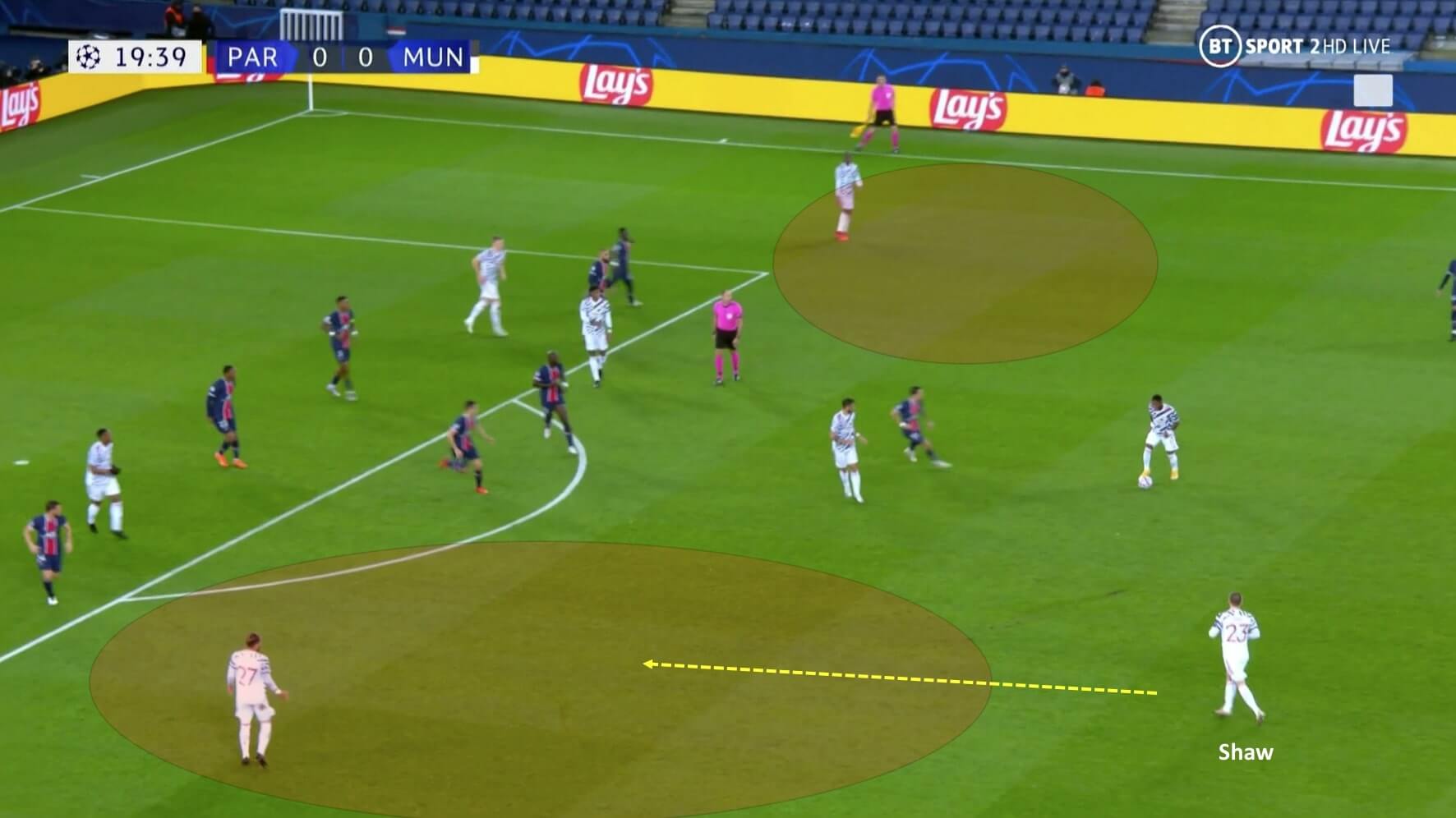
The figure shows that since Neymar and Mbappé did not drop deep, United maintained a numerical advantage in the opposition half. As Shaw received in the ball in the space, he drove the ball into the box for Anthony Martial who was fouled. Eventually, United received a penalty and took the lead.
PSG’s sluggish approach with the ball and United’s magnificent midfield duo
PSG’s attacking idea was to allow their full-backs to push forward and provide width across the vertical phases. To accommodate that, Herrera and Gueye constantly dropped into the full-back positions during the buildup, as shown in the figure below.
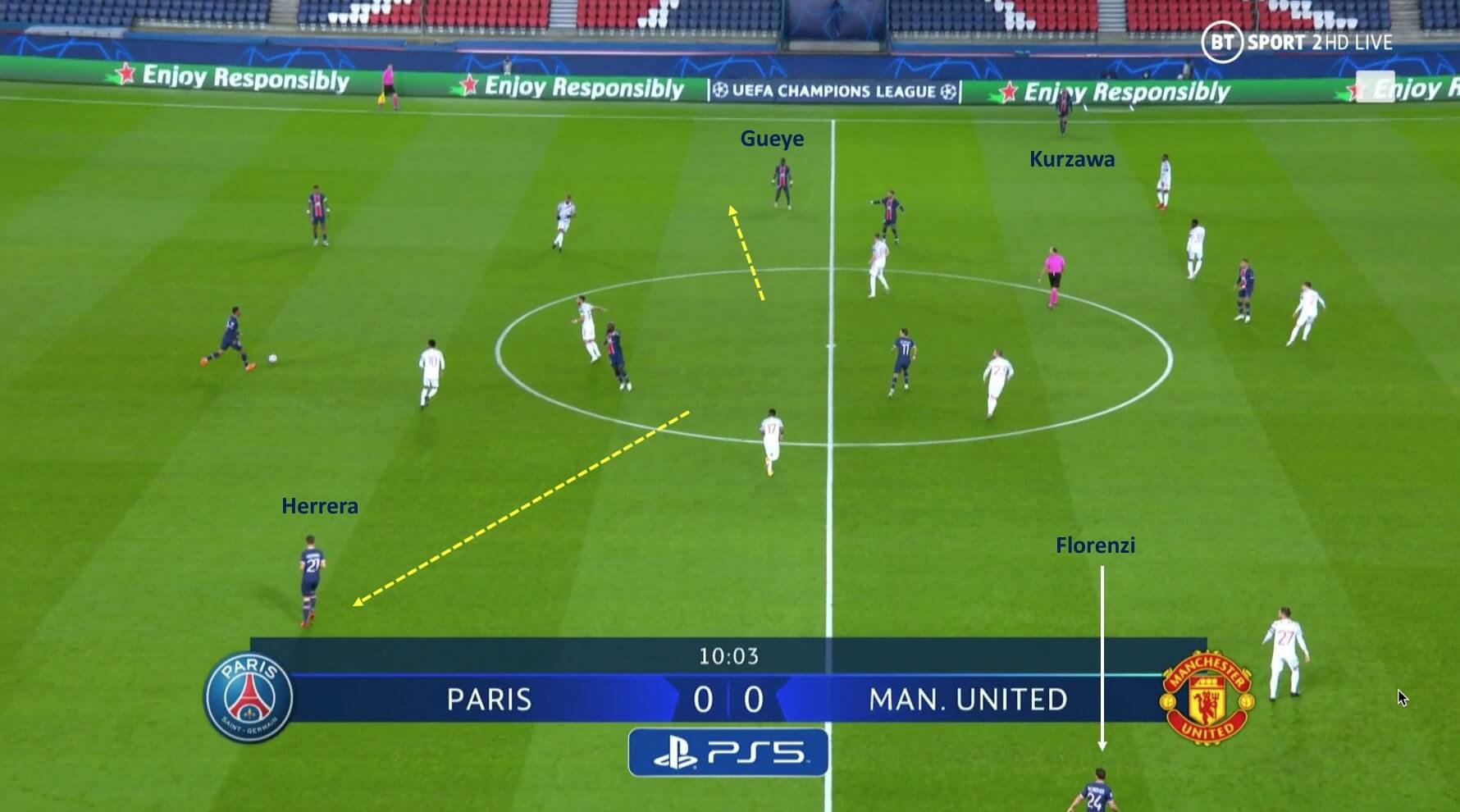
Besides, United played with two central midfielders in McTominay and Fred. With one of the attacking trio dropping deep, PSG tried to create problems in the final third using the overloads, as shown in one of the instances below.
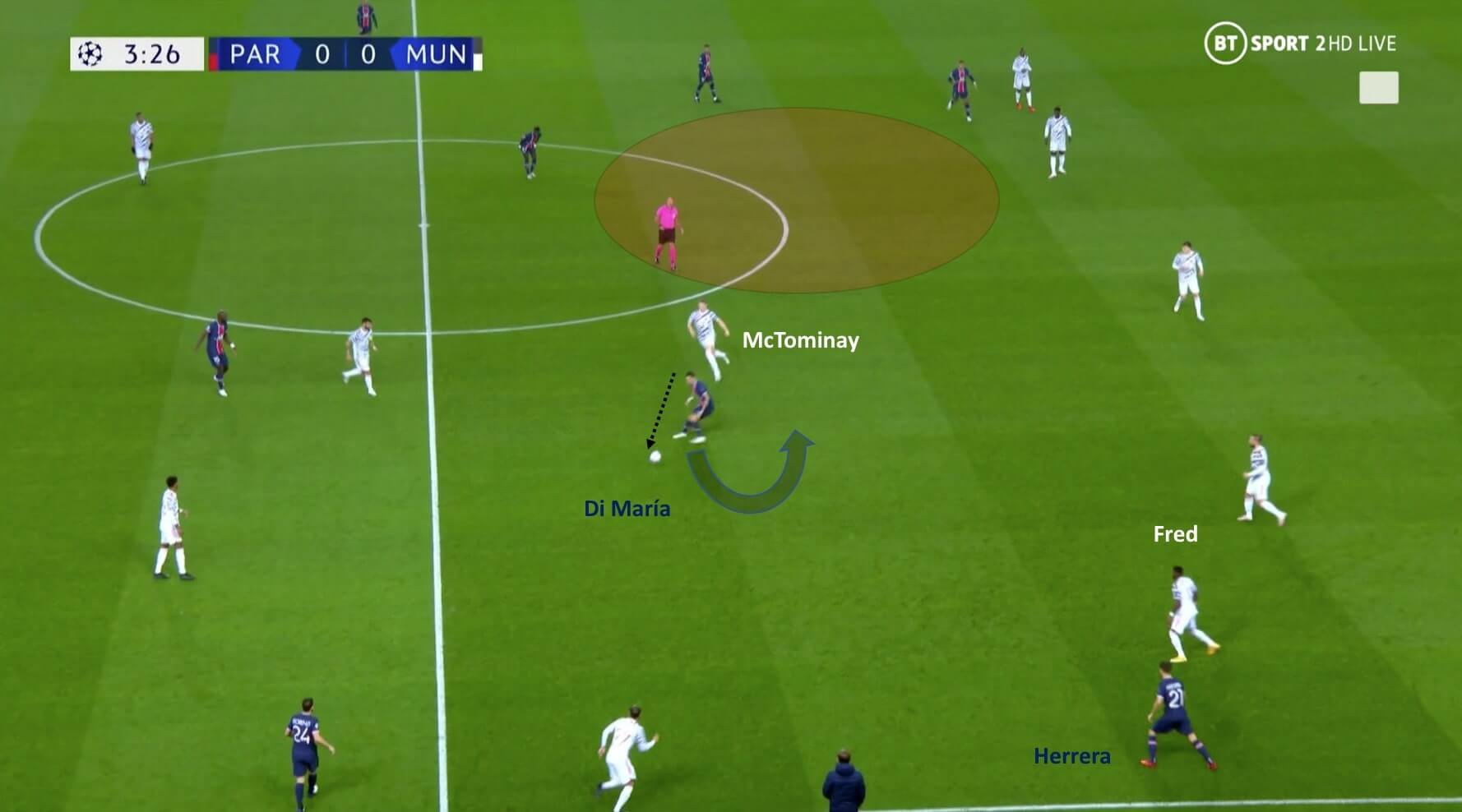
In the figure above, Herrera drew Fred away as Di María dropped centrally. As the Argentine was able to evade McTominay, PSG had ample space in front of United’s defensive line. Hence, the hosts were able to create spaces using smart movements and the presence of an extra midfield player in the opposition half.
Having said that, the French champions executed the plan sporadically, as the lack of intensity and rhythm in their possession play seldom troubled the United defence. This, combined with United’s efficient high pressing structure, as established in the previous section, prevented the hosts to swiftly progress the ball into the final third often during the first half. The following figures highlight the issue.
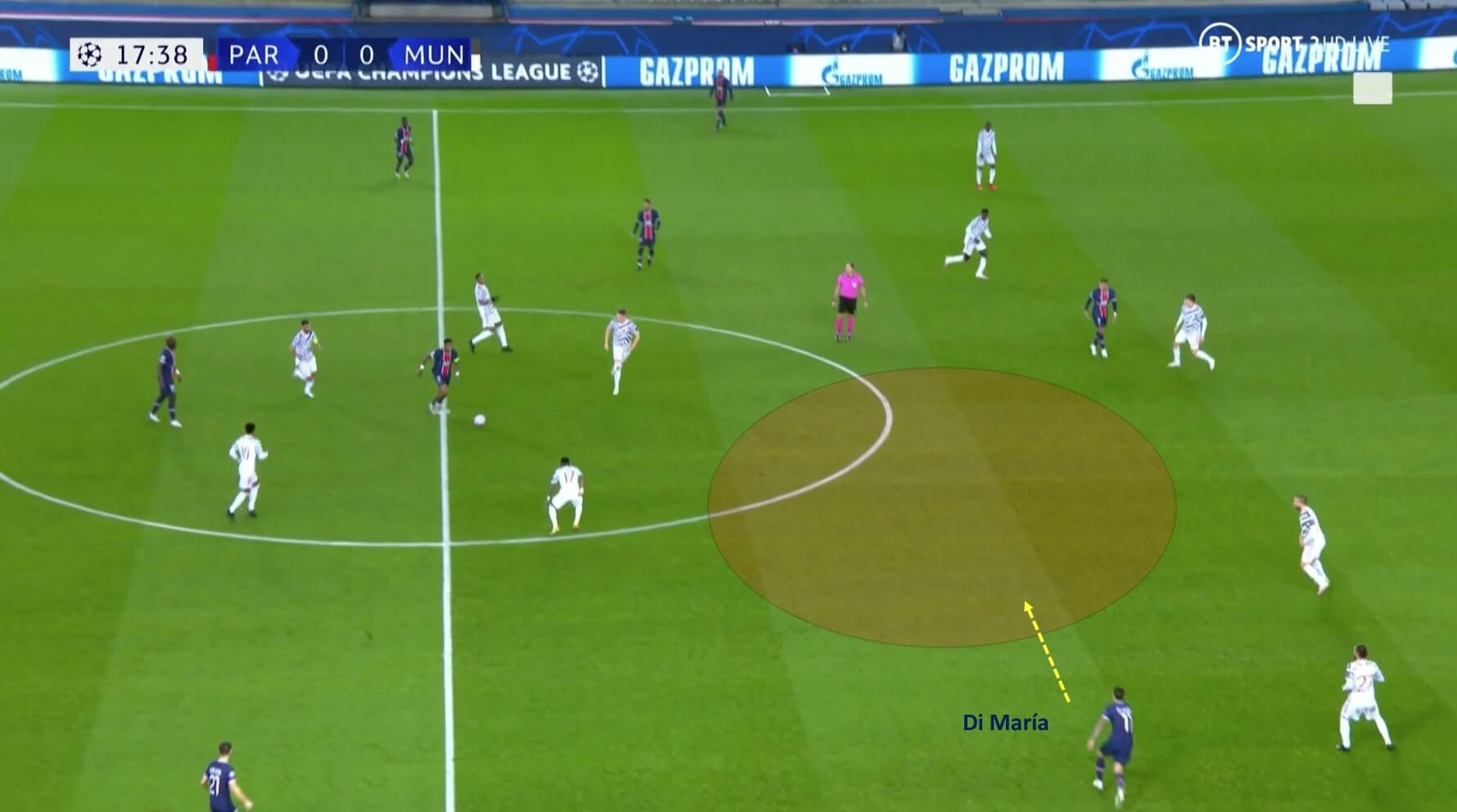
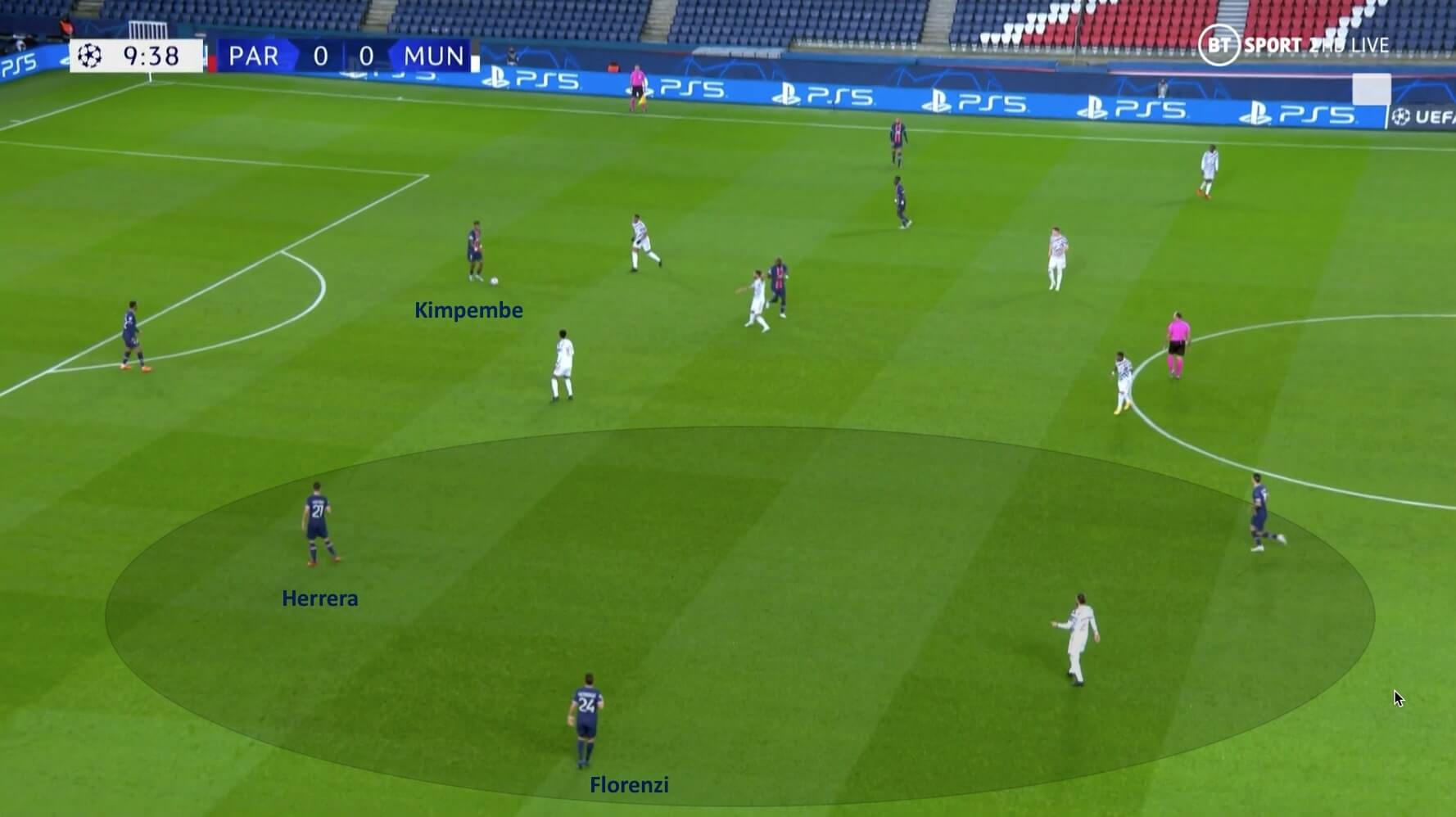
The slowness in PSG’s buildup forced Neymar to start dropping deep into the middle third to receive possession in space and attempt to progress the ball vertically. The Brazilian relied on his dribbling abilities against the likes to McTominay and Fred to create spaces in the final third. The 28-year old attempted 14 dribbles in the game, which was highest amongst all the players on the field. However, he was only able to complete five (36%) of them. Besides the Brazilian was only able to win seven out of his 22 attacking duels. 16 of those were against the United’s midfield duo.
While McTominay won 11 out of 24 total duels with a rate of 50%, Fred’s figure of winning 18 out of the 24 duels with 75% success rate was very impressive. These statistics show that the two midfielders won the battle in the middle of the park and once they were able to shut Neymar’s threat, PSG’s attacks fizzled out more often than not.
The following couple of figure shows an instance which highlights the work-rate and intensity that the United players showcased in the middle.

Moments before the image was taken, McTominay lost the ball as Gueye intercepted his header. The ex-Everton midfielder immediately looked for Neymar, who was positioned between the lines.
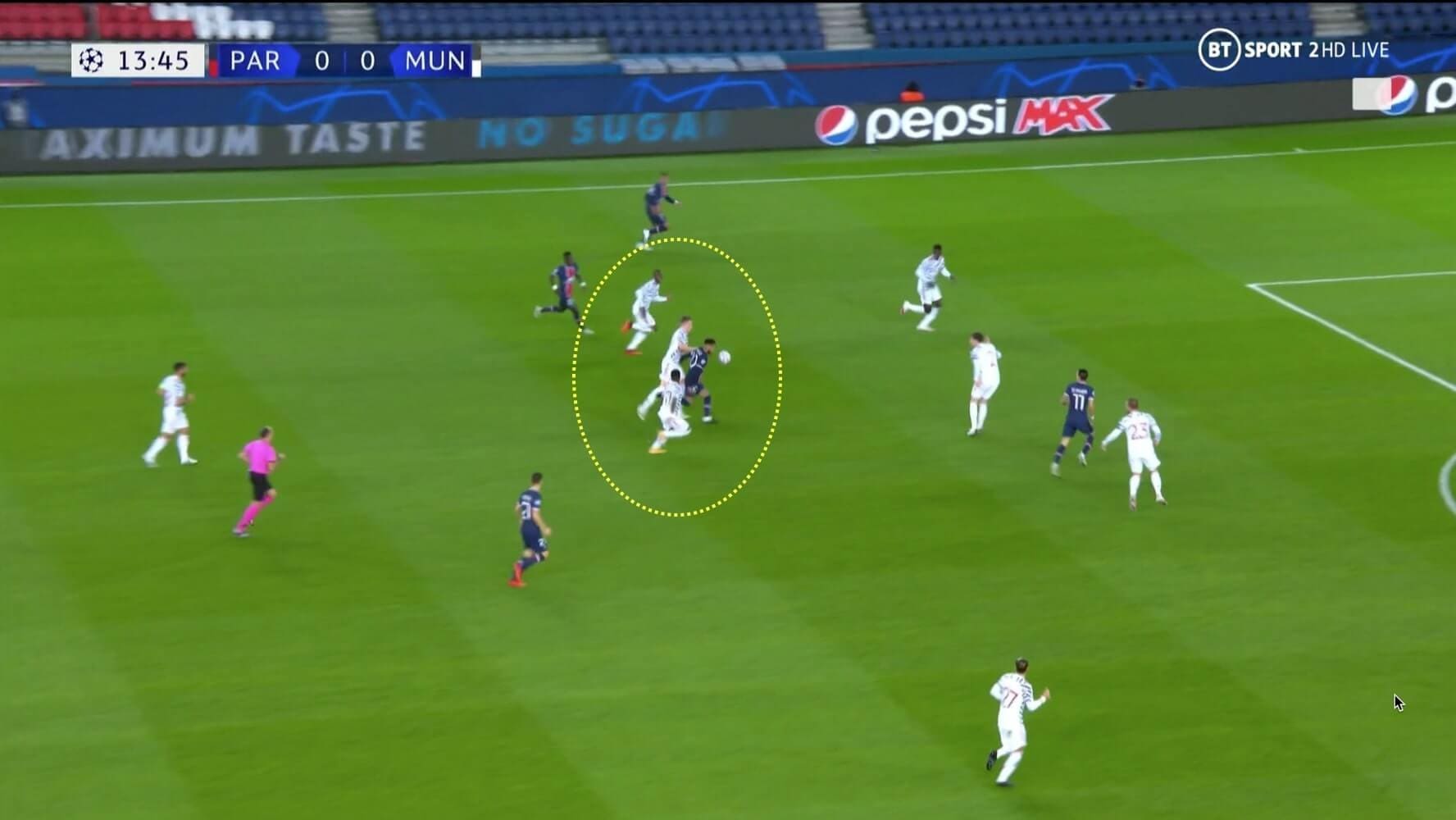
As soon as Neymar made a turn and looked to drive forward, Fred and McTominay quickly closed the Brazilian down without giving him any time to make an influence with the ball. Notice the distance that Fred covered for closing down his fellow Brazilian which exemplifies his concentration and work-rate.
Both the United midfielders were positionally disciplined as they stayed closer to each other during the defensive phase to effectively close down any available spaces in the defensive third.
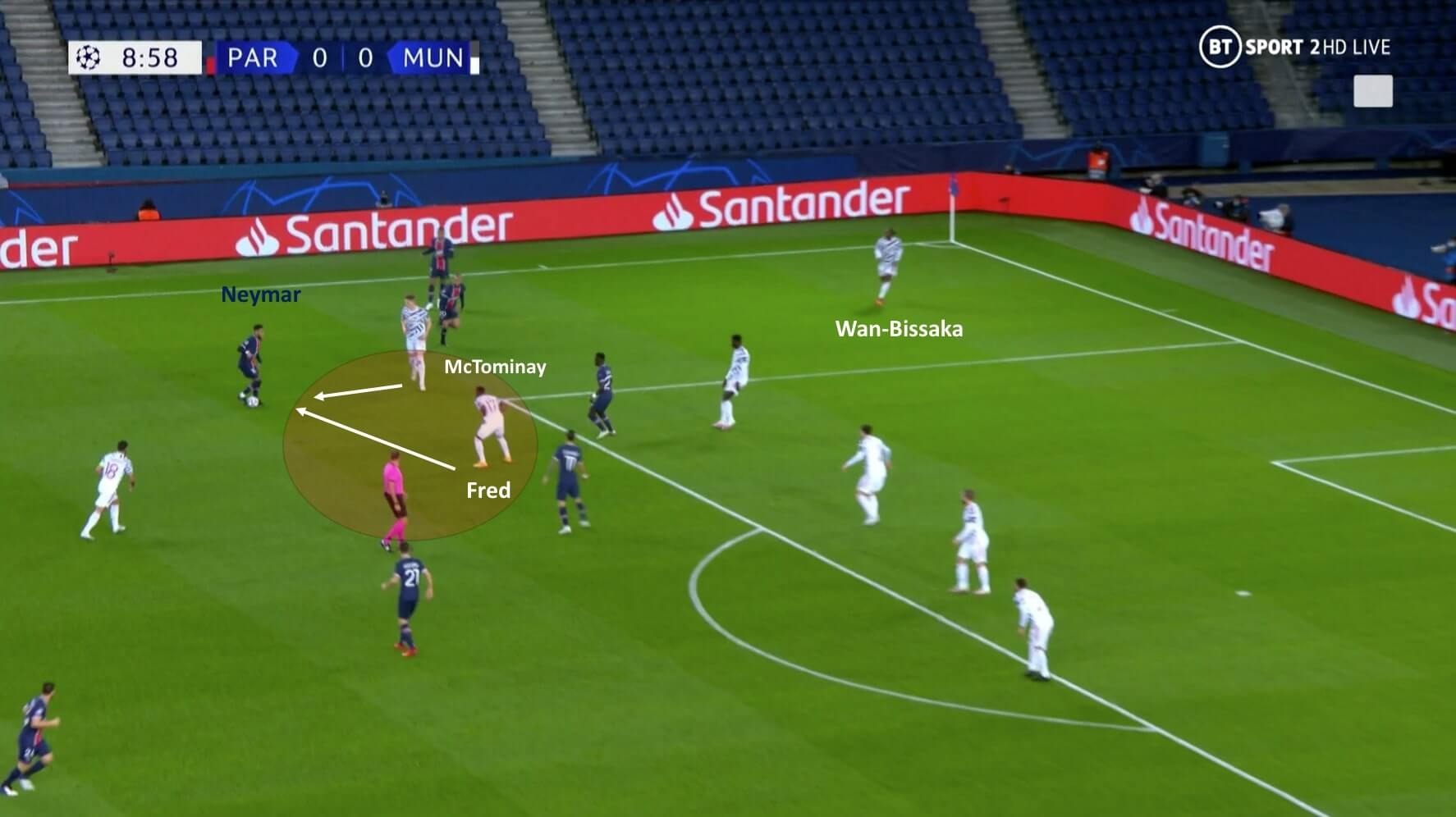
The figure above shows that as Wan-Bissaka was drawn out of his backline, McTominay and Fred compressed the horizontal and vertical shape to close the space in the inside channel as they looked to dispossess Neymar.
PSG’s change in the second half
After a dismal first half, Tuchel changed the system to 4-2-3-1 as he brought Moise Kean for Gueye, as shown in the following figure.
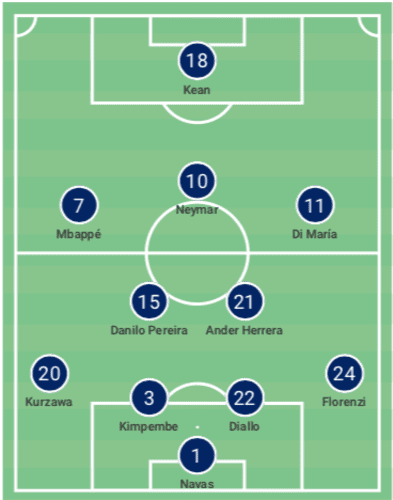
Les Parisiens started to build in a 4-2-4 kind of a system where the central defenders, along with the two pivots formed a box, while the full-backs provided width higher up the field, and the front four made fluid movements centrally, as shown in the following figure.
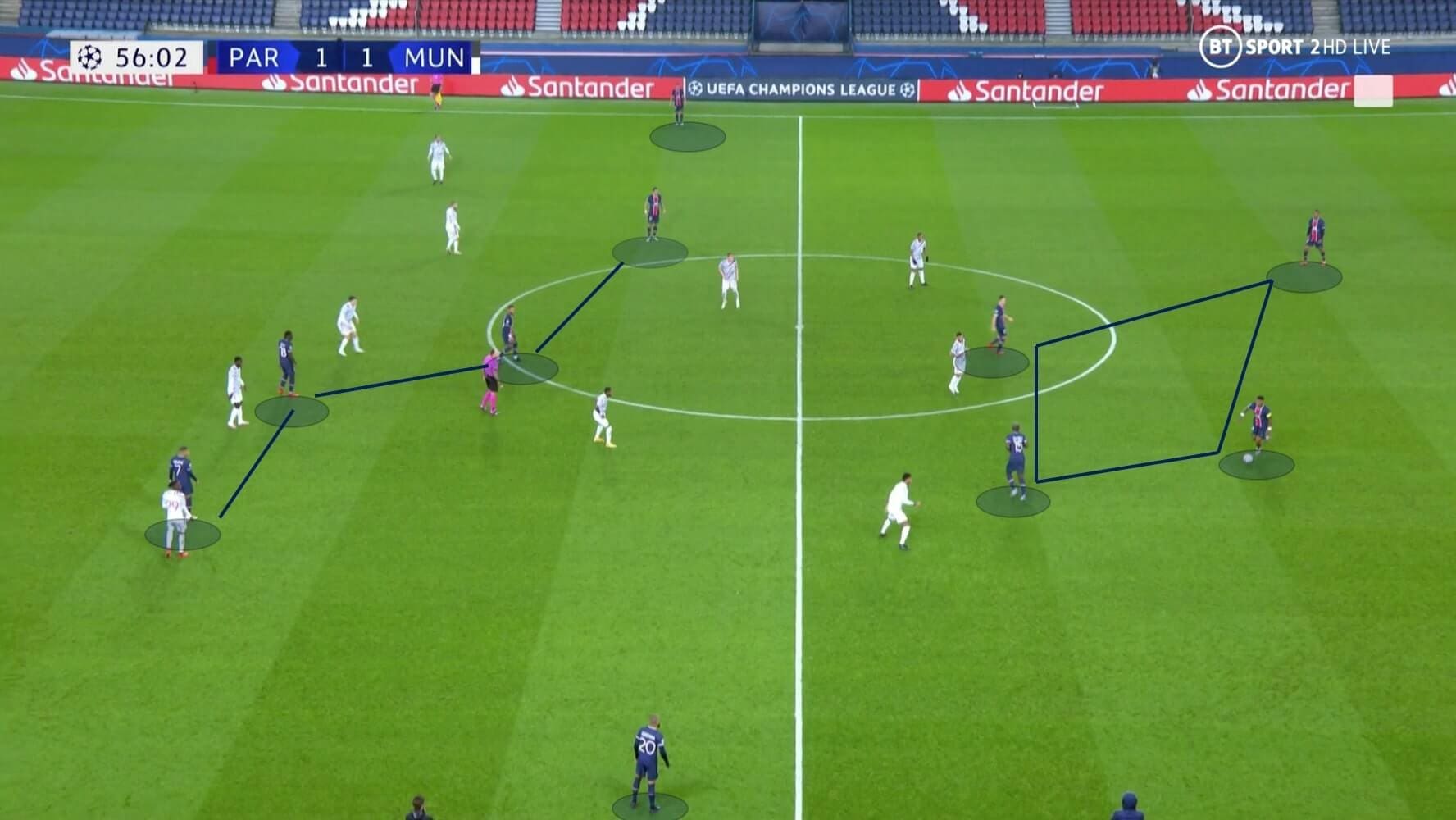
The idea behind the change was to create overloads across the thirds as it significantly improved PSG’s attacking output. In the defensive third, the addition of an extra midfielder, along with the full-backs dropping deeper, gave the hosts a numerical advantage at the back which allowed them to start building up swiftly as compared to the first half.
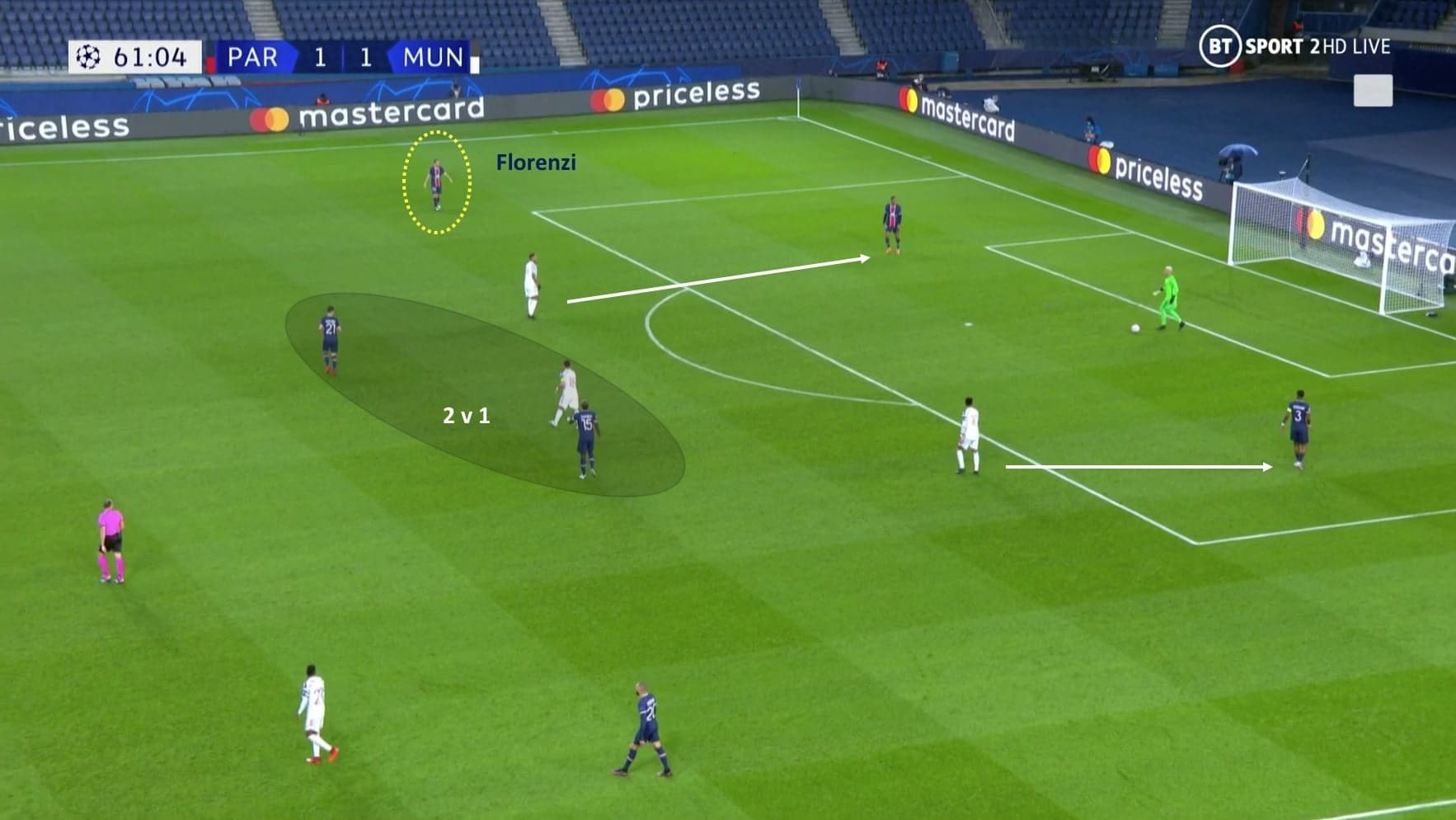
As shown in the figure above, PSG have the numerical superiority at the back as Fernandes is now isolated two versus one. Besides, Florenzi’s deep positioning meant that he could have the time before Telles can close him down. Along with time, the full-back also has more bodies around him to circulate the possession comfortably.
PSG also started to gain numerical superiority higher up the field. As Tuchel’s men were able to carry the ball out into the opposition half more frequently, Mbappé, Neymar, Di María, and Kean started to play centrally and position themselves between the United lines, outnumbering the visitors in the midfield, as shown in the figure below.
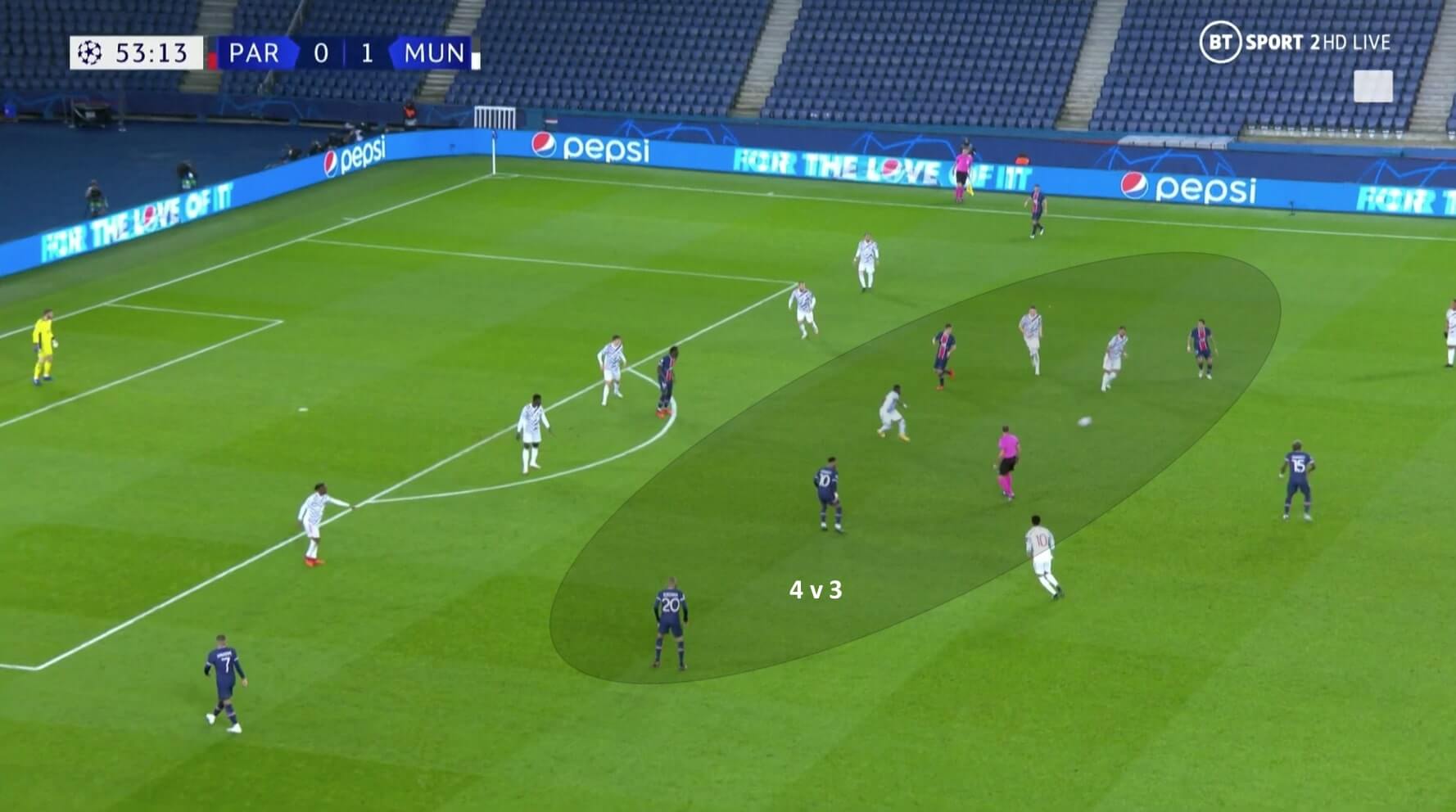
As the French champions started to get more bodies in front of the United backline, the shape of United’s defence and midfield lines were naturally compressed which allowed the PSG full-backs to provide width in the final third. While Kurzawa made underlapping/ overlapping runs based on Mbappé’s positioning, Mbappé started to make his favoured inside runs between United’s right-sided full-back and centre-back. Moreover, Di María began to drift centrally to find key passes as the visitors enjoyed their best moments of the game during the first quarter of the second half.
Even though Les Parisiens attacked better, the new approach came with a flaw that United exposed in attacking transitions. As the two pivots of PSG pushed up, it left their centre-backs without any cover across the wide channels. United kept Rashford and Martial up front, which meant that the PSG centre-backs had to stay tight on the two forwards.
However, when United won the possession in the middle third, they had ample space down the channels on either side as the Red Devils immediately looked to expose them on counter-attacks.

Seconds before the above image was snapped, McTominay and Fernandes combined to regain the ball from Kurzawa followed by a pass to Rashford in the half-space. Observe how Kimpembe has stuck to Rashford’s back in order to prevent him from turning. However, the 22-year old laid the ball to Wan-Bissaka and quickly made a turn, evading Kimpembe’s pressure to make a run beyond him.
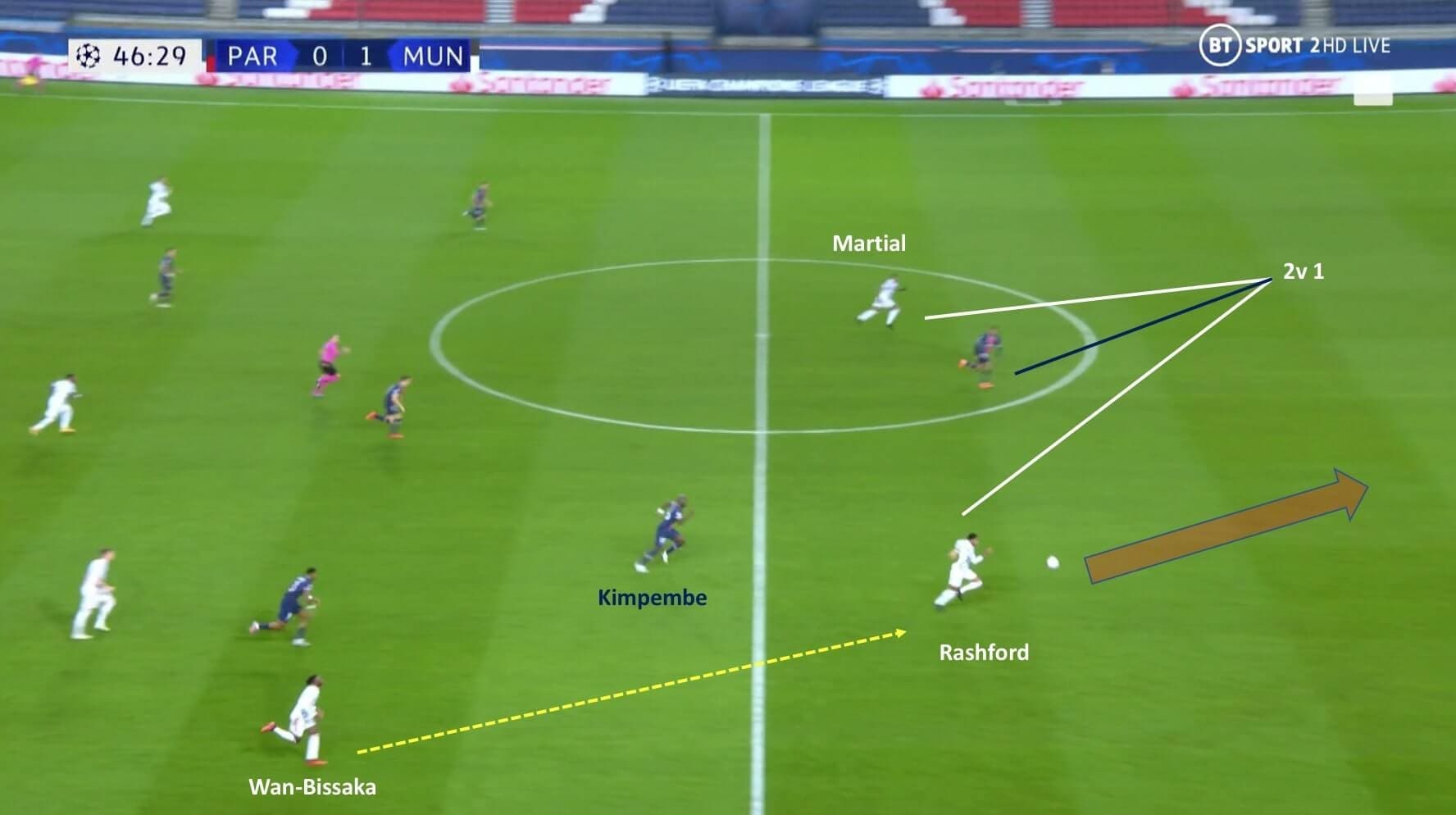
As Rashford was off, Wan-Bissaka’s ball down the right channel isolated the other centre-back against the two United forwards. United used this tactic significantly to hurt PSG during the second half.
United’s response – A diamond midfield
As PSG dominated the initial stages of the second half, Solskjær looked to regain control of the game by introducing Paul Pogba in the place of Telles and changing the formation to a 4-4-2 diamond, as shown in the following figure.
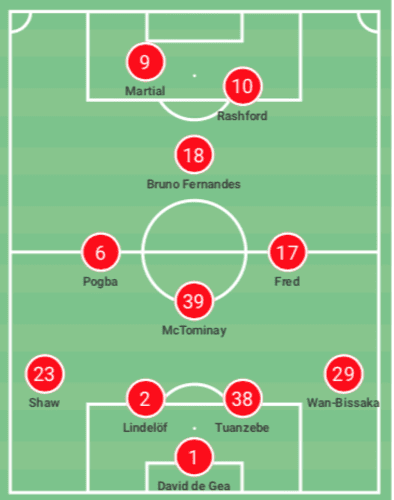
This was a tactical coup by the Norwegian as United reasserted their dominance across the thirds with this change. With an extra man in the midfield, Pogba eliminated the host’s numerical advantage during the buildup as United started to be effective in the high press once again. Pogba was tasked to press Florenzi, who was left free before the Frenchman’s arrival, as we saw in the previous section. Hence, the visitors choked the attacking outlets of the opposition again and forced possession turnovers in the PSG half. This is shown in the following figure.
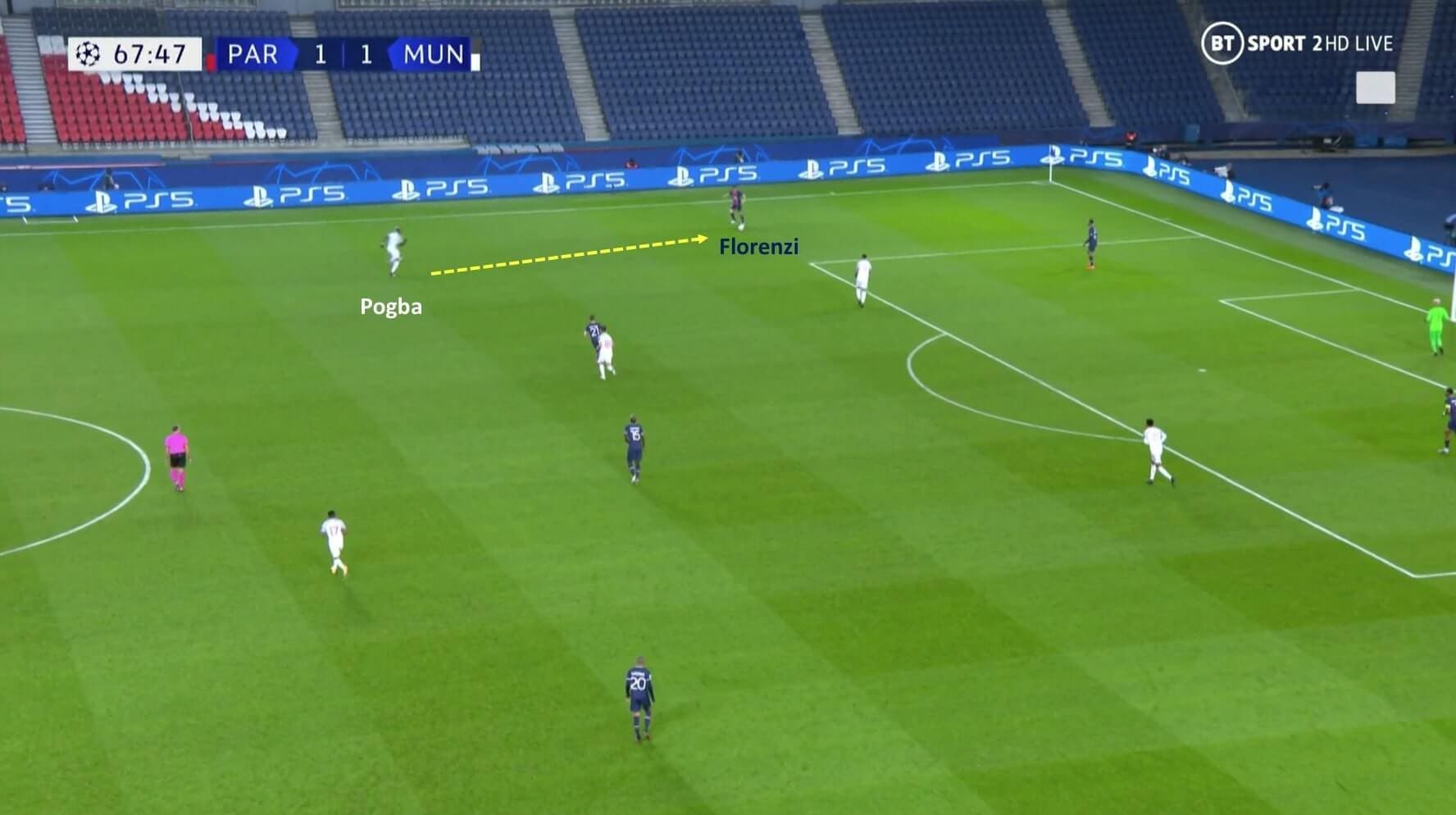
Not only that, Pogba being the box-to-box midfielder, dropped into the deeper areas to obliterate PSG’s numerical advantage, as the diamond midfield with possession transitioned into a flat 4-3-3, as shown in the following figure.
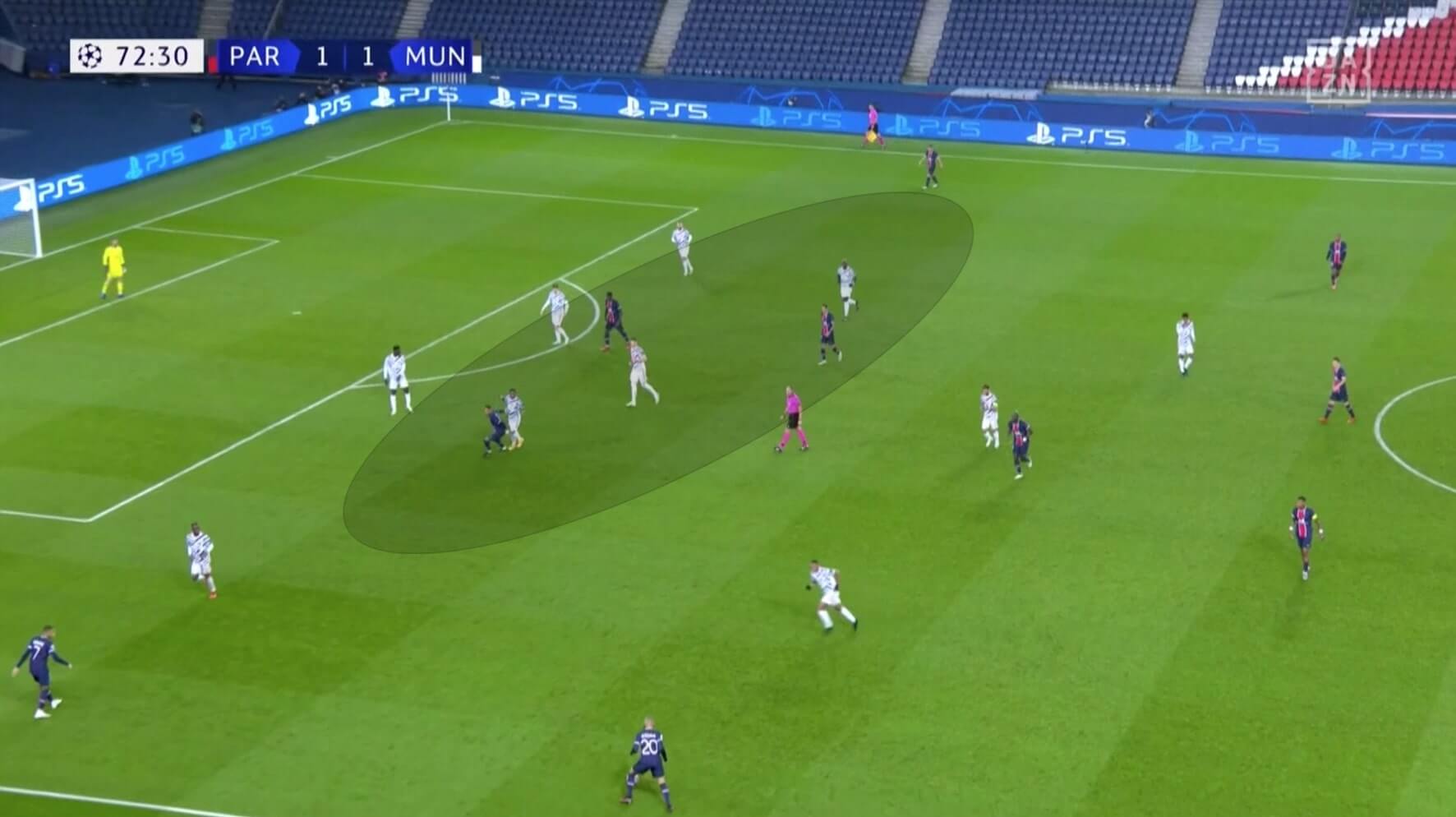
In the attacking phase, Pogba naturally provides more attacking output to the team than McTominay and Fred. Hence, the Frenchman’s introduction allowed him to play in an attacking role as the two pivots sat deeper. Consequently, he provided the assist for the winning goal of Rashford.
Conclusion
Overall, Manchester United dominated the last season’s finalists tactically as well as physically as they left Paris with a deserved win. This is an important win for Solskjær and his team, considering that they are in arguably the toughest group of the campaign.
PSG travel to Turkey with a hope to secure three points when they face İstanbul Başakşehir in the next round of fixtures. As for United, they welcome PSG’s semi-final opponent of the previous season, Julian Nagelsmann’s RB Leipzig, at Old Trafford for what is anticipated to be an intriguing fixture and yet another important one for the Red Devils.





Comments